
Meretseger was a Theban cobra-goddess in ancient Egyptian religion, in charge with guarding and protecting the vast Theban Necropolis — on the west bank of the Nile, in front of Thebes — and especially the heavily guarded Valley of the Kings. Her cult was typical of the New Kingdom of Egypt.

Deir el-Medina, or Dayr al-Madīnah, is an ancient Egyptian workmen's village which was home to the artisans who worked on the tombs in the Valley of the Kings during the 18th to 20th Dynasties of the New Kingdom of Egypt The settlement's ancient name was Setmaat, and the workmen who lived there were called "Servants in the Place of Truth". During the Christian era, the temple of Hathor was converted into a Monastery of Saint Isidorus the Martyr from which the Egyptian Arabic name Deir el-Medina is derived.

Neferkare Setepenre Ramesses IX was the eighth pharaoh of the Twentieth Dynasty of Egypt. He was the third longest serving king of this Dynasty after Ramesses III and Ramesses XI. He is now believed to have assumed the throne on I Akhet day 21 based on evidence presented by Jürgen von Beckerath in a 1984 GM article. According to the latest archaeological information, Ramesses IX died in Regnal Year 19 I Peret day 27 of his reign. Therefore, he enjoyed a reign of 18 years, 4 months and 6 days. His throne name, Neferkare Setepenre, means "Beautiful Is The Soul of Re, Chosen of Re." Ramesses IX is believed to be the son of Mentuherkhepeshef, a son of Ramesses III, since Mentuherkhopshef's wife, the lady Takhat bears the prominent title of King's Mother on the walls of tomb KV10, which she usurped and reused in the late 20th Dynasty; no other 20th Dynasty king is known to have had a mother with this name. Ramesses IX was, therefore, probably a grandson of Ramesses III.

Khepermaatre Ramesses X was the ninth pharaoh of the 20th Dynasty of Ancient Egypt. His birth name was Amonhirkhepeshef. His prenomen or throne name, Khepermaatre, means "The Justice of Re Abides."

The Valley of the Queens is a site in Egypt, in which queens, princes, princesses, and other high ranking officials were buried. Pharaohs themselves were buried in the Valley of the Kings. The Valley of the Queens was known anciently as Ta-Set-Neferu, which has a double meaning of "The Place of Beauty" and/or "the Place of the Royal Children". Excavation of the tombs at the Valley of the Queens was pioneered by Ernesto Schiaparelli and Francesco Ballerini in the early 1900s.
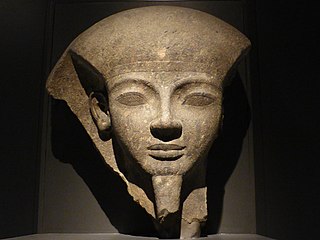
Ramesses VI Nebmaatre-Meryamun was the fifth ruler of the Twentieth Dynasty of Egypt. He reigned for about eight years in the mid-to-late 12th century BC and was a son of Ramesses III and queen Iset Ta-Hemdjert. As a prince, he was known as Ramesses Amunherkhepeshef and held the titles of royal scribe and cavalry general. He was succeeded by his son, Ramesses VII Itamun, whom he had fathered with queen Nubkhesbed.

The necropolis of Sheikh Abd el-Qurna is located on the West Bank at Thebes in Upper Egypt. It is part of the archaeological area of Deir el-Bahari, and named after the domed tomb of the local saint. This is the most frequently visited cemetery on the Theban west bank, with the largest concentration of private tombs.

The Theban Necropolis is a necropolis on the west bank of the Nile, opposite Thebes (Luxor) in Upper Egypt. It was used for ritual burials for much of the Pharaonic period, especially during the New Kingdom.

Sennedjem was an Ancient Egyptian artisan who was active during the reigns of Seti I and Ramesses II. He lived in Set Maat, contemporary Deir el-Medina, on the west bank of the Nile, opposite Thebes. Sennedjem had the title "Servant in the Place of Truth". He was buried along with his wife, Iyneferti, and members of his family in a tomb in the village necropolis. His tomb was discovered January 31, 1886. When Sennedjem's tomb was found, it contained furniture from his home, including a stool and a bed, which he used when he was alive.
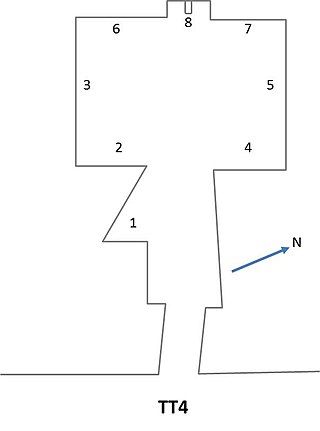
The Theban Tomb TT4 is located in Deir el-Medina, part of the Theban Necropolis, on the west bank of the Nile, opposite to Luxor. It is the burial place of the ancient Egyptian artisan named Qen.
Qen was an Ancient Egyptian artisan. Qen lived in Deir el-Medina on the west bank of the Nile, opposite Thebes, during the reigns of Ramesses II. His titles included Servant in the Place of Truth, meaning that he worked on the excavation and decoration of nearby royal tombs. He was buried in a tomb in the village necropolis.
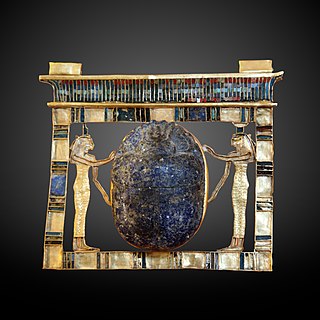
Paser was an ancient Egyptian noble who served as vizier during the reigns of Seti I and Ramesses II in the 19th Dynasty. He would later also become High Priest of Amun.
Khabekhnet was an Ancient Egyptian artisan. Khabekhnet lived in Deir el-Medina on the west bank of the Nile, opposite Thebes, during the reign of Ramesses II. He was a son of Sennedjem and Iyneferti, and was married to Sahti and probably Isis. He was buried in Tomb TT2 in the village necropolis.
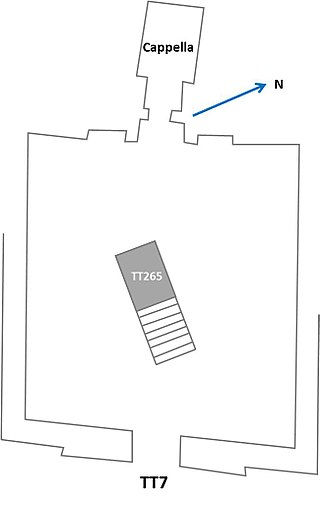
The Theban Tomb TT7 is located in Deir el-Medina, part of the Theban Necropolis, on the west bank of the Nile, opposite to Luxor. It is the burial place of the ancient Egyptian artisan named Ramose, who lived during the 19th Dynasty, during the reign of Ramesses II.

The Theban Tomb TT10 is located in Deir el-Medina, part of the Theban Necropolis, on the west bank of the Nile, opposite Luxor. It is the burial place of the ancient Egyptian artisan named Penbuy, who lived during the 19th Dynasty. Penbuy shared his tomb with Kasa, also a Servant in the Place of Truth.

The Theban Tomb TT58 is located in Sheikh Abd el-Qurna, part of the Theban Necropolis, on the west bank of the Nile, opposite to Luxor. The tomb was originally carved for a courtier dating to the time of Amenhotep III and later usurped during the Ramesside period.
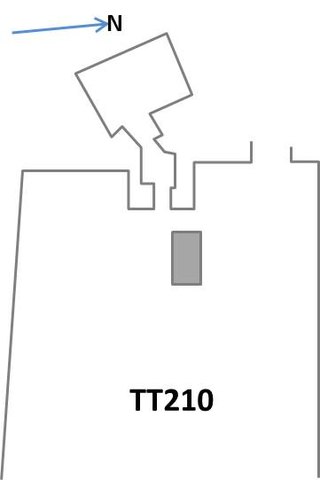
The Theban Tomb TT210, part of the Theban Necropolis, is located in Deir el-Medina, on the west bank of the Nile, opposite to Luxor. TT210 is the burial place of the ancient Egyptian artisan named Raweben, who lived during the 19th Dynasty. Raweben would have lived in Deir el-Medina during the reign of Ramesses II.

The Theban Tomb TT212 is located in Deir el-Medina, part of the Theban Necropolis, on the west bank of the Nile, opposite to Luxor.

The Theban Tomb TT214 is located in Deir el-Medina, part of the Theban Necropolis, on the west bank of the Nile, opposite to Luxor.

Khawy was a guardian in the Place of Truth and servitor of Amun of Opet (Luxor) from the reign of Ramesses II. He lived in the workers village Deir el-Medina. Khawy is known from his tomb TT214, his house and several other inscriptions.


















